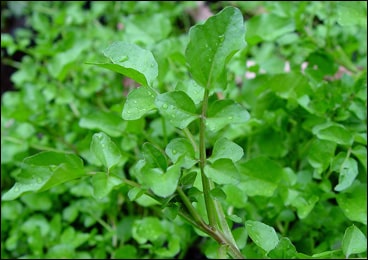
Overview
Watercress is an aquatic, perennial plant with stems that can grow up to 50 cm of length. It is commonly known as a salad crop mostly gathered from the wild but the plant is also grown for commercial use. Watercress is a mineral and vitamin-rich, healthy food. It is used for various medicinal purposes.
What are the other Common names used for Watercress?
Berro, Tall Nasturtium, Brooklime, Brown cress, Cresson, Cresson Des Jardins, Habb Ar Rashad, Hurf Al May, Suteresi and Witte Waterkers.
What is the Botanical name of Watercress?
Nasturtium officinale.
What is the Scientific Classification of Watercress?
- Kingdom – Plantae
- Phylum – Magnoliophyta
- Class – Magnoliopsida
- Order – Brassicales
- Family – Brassicaceae
- Genus – Nasturtium
- Species – Officinale
General Description of Watercress
It is mainly grown in the temperate zone but can also be cultivated in the tropics. This plant has a creeping rootstock and a hollow stem which grows up to 1-2 feet in length. Leaves are above the water and they are smooth, fleshy, dark green in color. Leaflets are round and the terminal is one larger than the other. On extremity of branches, there are small and white flowers. Seeds of the Nasturtium officinale or Indian cress are used as the substitute for capers in pickles.
Where is Watercress Commonly Cultivated?
Cultivation of Watercress is usually for commercial use on a large scale. It can be grown without soil using only mineral nutrient solutions in a water solvent. This plant is often cultivated for its edible leaves. Clean water is required for its cultivation as it is pollution sensitive.
Where is Watercress Distributed?
It is commonly found in Northern Asiatic countries and Europe. Watercress is also distributed throughout the world in temperate regions.
Which is the Flowering Season of the Watercress?
The white flowers of the Watercress bloom generally during the months of the summers.
How can Watercress be used for the Edible Purpose?
Leaves are mainly used for eating as it is rich in vitamins and minerals, mainly iron. Leaves can be had with or without cooking. It is mainly used for the garnishing purpose as a salad. Its flavors are characteristic and strong. Watercress is used as the spring tonic and can be harvested and picked for almost 10 times in a year. Seeds can be eaten in a sprouted form or in salads. These seeds have the mustardy flavor so they are used in the powdered form as mustard.
Which parts of the Watercress is used for the Medicinal Purpose?
Its leaves, seeds, and flowers are mostly used for commercial and medicinal purposes.
What are the Medicinal uses of Watercress?
- It improves digestion as the leaves of Watercress have rich content of Vitamin and minerals.
- Watercress has rich content of vitamin C, so it is considered a cleansing herb.
- This herb is considered a very effective remedy for chronic illnesses.
- Watercress has a diuretic action which increases quantity and frequency of urination.
- It helps to maintain blood sugar level in a diabetic patient by lowering the level of blood sugar in the body.
- This herb is considered to have detoxifying and purifying actions. It removes free radicals and prevents the body from its harmful effects.
- After the pain of tooth extraction can be relieved by the use of this herb.
- Watercress increases the activity of the central nervous system and body.
- It promotes the appetite and assists the digestion.
- This herb facilitates or stimulates evacuation of the bowels.
- Freshly prepared juice of Watercress can be used to treat various kidney and chest complaints.
- Chronic irritation and inflammations can be treated by the use of this herb.
- Watercress can be used as a hair tonic which promotes the growth of healthy and voluminous hair.
- It can be used as an effective treatment for lymphatic swellings and glandular tumors.
- Since ages, it has been used to treat bronchitis and coughs .
- Soup of the Watercress is used in China to treat canker sores on the lips or tongue, swollen gums, aphthae, foul breath, and bad teeth.
- It is used to eliminate accumulated fluids in the body tissues such as in gout.
- This herb has an expectorant action which means it helps to clear mucus from airways.
- Watercress juice is used to treat skin conditions like acne, eczema, rashes, and ringworm.
- It is known as a stone breaker as this herb help to break up kidney and bladder stones.
- This herb is also used in the treatment of tuberculosis and scurvy.
- In homeopathy it is used to treat constipation, stricture of urinary organs, hysteria, cirrhosis of liver and dropsy. It is also used to antidote tobacco.
What can be the Side Effects of Watercress?
- One having the intestinal disorders or ulcers should not use Watercress as it can worsen the condition.
- It should not be used during pregnancy as it may start bleeding and result in miscarriage.
- During breast-feeding Use of Watercress should be avoided as it may effect both child and the mother.
